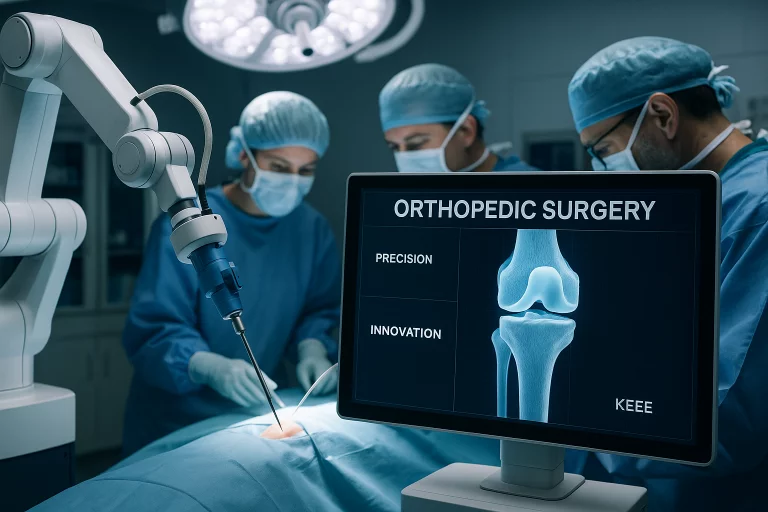Introduction to Robotic Technology in Orthopedics
Robotic technology has ushered in a paradigm shift in orthopedic surgery, providing surgeons with unparalleled precision, control, and three-dimensional visualization. Unlike traditional manual approaches that often rely on a surgeon’s experience and tactile feedback, robotic-assisted systems utilize state-of-the-art tools combined with computer-guided software. These systems, such as the MAKO Surgical System, begin by utilizing advanced imaging techniques, including CT scans, to generate a highly detailed 3D model of a patient’s unique anatomy. This model enables surgeons to meticulously plan every step of the procedure prior to entering the operating room, allowing for millimeter-level precision in bone cuts and implant placement. A prime example of this innovation in action is minimally invasive MAKO knee replacement surgery in Tulsa, where patients benefit from a tailored surgical approach that promotes faster recovery and greater joint function.
The incorporation of robotic technology translates into unmatched surgical accuracy. Every movement, whether it’s an incision, bone resection, or implant insertion, is executed with exceptional precision and real-time feedback, dramatically minimizing the potential for human error. This ultra-precise approach not only helps avoid inadvertent injuries to critical tissues and structures but also leads to consistently improved patient outcomes, quicker recoveries, and reduced complications. As a result, the growing adoption of robotics is transforming orthopedic care for both surgeons and patients, setting a new gold standard in the pursuit of better health and mobility.

Key Advantages of Robotic-Assisted Surgeries
- Enhanced Precision: Robotic systems enable surgeons to perform bone resections and implant placements with sub-millimeter accuracy, a level of precision unmatched by manual techniques. By mapping out surgery in a computerized environment, robotics helps safeguard vital soft tissues, nerves, and ligaments. This meticulous approach ensures the proper alignment and stability of joints, significantly prolonging the durability and effectiveness of surgical implants while supporting optimal postoperative joint function.
- Minimally Invasive Procedures: One of the most significant benefits of robotic technology is the ability to conduct surgeries through much smaller incisions. These minimally invasive approaches reduce trauma to muscles and surrounding soft tissues, which in turn lead to less postoperative pain, a quicker return to mobility, reduced scarring, and a diminished risk of infection or other complications. For patients, this translates to shorter hospital stays, faster rehabilitation, and a swifter return to daily life.
- Personalized Surgical Plans: Preoperative 3D modeling and planning enable the design of surgeries explicitly tailored to a patient’s bone structure and anatomy. By creating personalized, data-driven surgical strategies, robotics ensures maximal compatibility between the patient’s body and the implanted components. This level of customization enhances not just immediate surgical outcomes but also the long-term functionality and lifespan of the replaced joint.
These clear advantages position robotic-assisted orthopedic procedures far ahead of conventional manual surgeries, particularly for active individuals who want to reclaim their quality of life and return to their favorite activities as quickly and safely as possible.
Applications in Joint Replacement Surgeries
The most widespread and rapidly adopted application of robotic technology in orthopedics lies within joint replacement surgeries, notably knee and hip replacements. Robotic platforms, such as the MAKO and ROSA, are revolutionizing these procedures by facilitating precise preoperative planning, real-time intraoperative guidance, and continuous validation of implant alignment. With these advanced systems, orthopedic surgeons can tailor the surgical approach to each patient’s unique joint structure and movement patterns, resulting in procedures that closely mirror the individual’s natural biomechanics. This technology is invaluable in correcting deformities and ensuring proper limb alignment, which are crucial for maintaining joint function and minimizing wear on implants.
The exceptional accuracy enabled by these robotic tools dramatically reduces the likelihood of implant misalignment, one of the primary causes of joint failure and revision surgeries. When implants are positioned with near-perfect precision, the joint can function more naturally, experience less abnormal wear, and last significantly longer. Studies and clinical evidence consistently reveal that patients undergoing robotic-assisted joint replacements experience less pain, more rapid rehabilitation, and superior long-term outcomes compared to traditional approaches. Whether for primary or complex revision cases, robotic joint replacement is swiftly becoming the preferred option for both patients and surgeons seeking reliable, lasting results.
Role in Spinal Surgeries
Robotics is not limited to joint surgery; it is simultaneously transforming the realm of spinal procedures. Robotic platforms such as Mazor X and ExcelsiusGPS are providing spine surgeons with unparalleled accuracy for placing screws, rods, and other hardware, even in the most complex or minimally invasive cases. These systems utilize continuous real-time navigation and guidance, allowing surgeons to precisely target anatomical landmarks and avoid vital neural and vascular structures, which are particularly critical in spinal surgery. The result is a significant reduction in surgical risks and complications, as hardware placement errors are minimized to virtually zero.
Additionally, robotic-assisted spinal surgeries routinely necessitate smaller incisions and lead to much less muscle disruption. Thanks to this minimally invasive approach, patients experience significantly less postoperative pain, shorter hospital stays, and a faster overall recovery. By increasing both the safety and accuracy of these challenging operations, robotic technology allows surgeons to confidently tackle complex deformities, spinal tumors, or degenerative conditions that previously might have required open, high-risk procedures.
Impact on Surgical Training and Education
The wave of robotic technology sweeping through orthopedic surgery is also revolutionizing the way surgeons are trained and educated. Robotic simulators are now an integral part of many residency and fellowship programs, offering a no-risk environment for early-career surgeons to develop essential skills. These simulators enable residents, fellows, and even veteran surgeons to practice a wide range of procedures repeatedly, troubleshoot challenging surgical scenarios, and refine their techniques without ever placing a patient at risk.
This innovative approach to training accelerates the learning curve, fosters greater comfort with complex technology, and builds a higher level of technical proficiency and confidence among operating teams. By allowing surgical trainees to practice on virtual cases that accurately replicate human anatomy and surgical situations, robotic education is laying the groundwork for higher standards, improved consistency, and safer patient outcomes across the global orthopedic community.
Challenges and Considerations
- High Costs: The adoption of robotic systems involves significant capital investment in both the initial purchase and ongoing maintenance of the equipment. These financial barriers can pose significant challenges, particularly for smaller community hospitals, rural centers, or underfunded facilities, potentially limiting access to care for patients in certain regions.
- Learning Curve: Implementing and mastering robotic surgical technology requires dedicated training for surgeons and operating room staff. While simulation helps, integrating these complex systems into regular practice demands time, collaborative effort, and can disrupt existing workflows until proficiency is achieved.
- Technical Issues: As with any advanced technology, robotic systems are susceptible to software bugs, hardware malfunctions, and connectivity issues. Intraoperative technical failures can lead to surgical delays or necessitate conversion to traditional techniques, adding an element of unpredictability that must be managed with careful preparation and troubleshooting protocols.
Despite these considerations, the profound benefits of robotics in improving surgical quality, safety,
Conclusion
Robotic technology is redefining the landscape of orthopedic surgery, bringing unmatched precision, personalization, and efficiency to procedures that once relied heavily on manual skill and tactile feedback. From joint replacements to spinal surgeries, robotic-assisted systems empower surgeons to deliver consistently superior outcomes with fewer complications and faster recovery times. They are also shaping the future of surgical education, offering advanced simulation tools that accelerate learning and enhance proficiency. While challenges such as high costs, steep learning curves, and technical limitations remain, the overall trajectory is clear: robotic-assisted surgery is setting a new benchmark in orthopedic care, improving both the patient experience and the quality of clinical outcomes.

